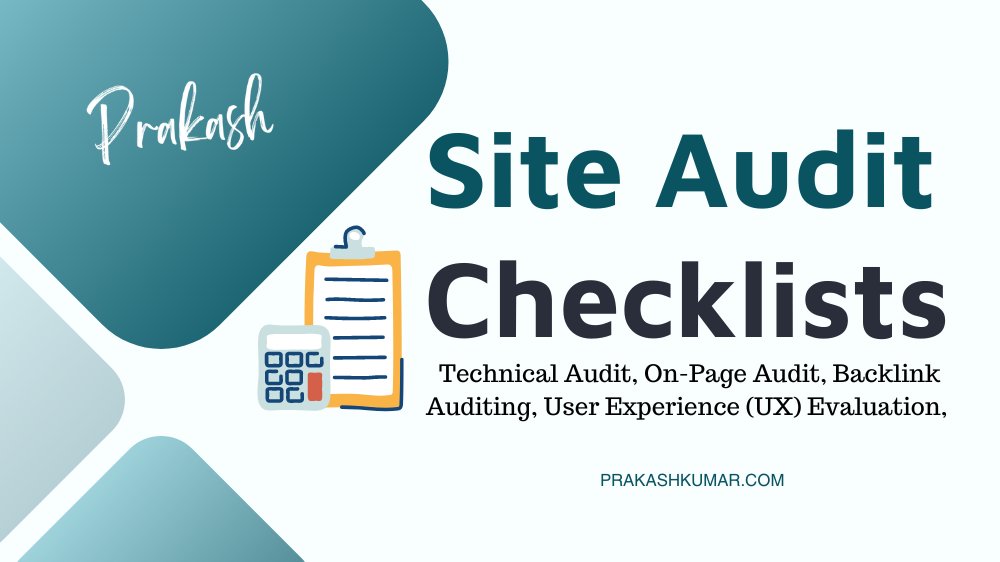Hi, I am Prakash Kumar, a die-hard fan of SEO 🙂
Some of my clients call me “An SEO Expert”, Some calls me “SEO Specialist”.
But Personally I only try to go in-depth with SEO and bring out a new strategy and concept which will help my clients in their site and business growth.
As Well as I also take care of my readers who read my blog to learn SEO strategies 😉
In this post I have covered the Step by Step guide of how to perform SEO Auditing of any website?
Performing a website SEO audit involves evaluating your site’s overall health, identifying issues, and making improvements to enhance its search engine visibility.
Here’s a step-by-step guide to help you conduct a comprehensive SEO audit:
Free Site Audit SEO Tool
https://www.seoptimer.com/
https://seositecheckup.com/
https://neilpatel.com/seo-analyzer/
https://seomator.com/free-seo-audit-tool
Step By Step Guide to Perform SEO Website Audit
Step 1 : Define Your Goals and Objectives
Before you start the audit, determine what you want to achieve. Are you looking to improve rankings, increase organic traffic, or fix specific issues? Clear goals will guide your audit process.
Step 2: Gather Necessary Tools
Collect the tools you’ll need for the audit, such as:
- Google Analytics: For traffic analysis.
- Google Search Console: To monitor site performance and indexation.
- SEO Tools: Like Moz, SEMrush, Ahrefs, or Ubersuggest for deeper insights.
- Screaming Frog or Sitebulb: To crawl your website and identify technical issues.
- Spreadsheets: For organizing data and tracking changes.
Step 3: Perform Technical Audit
This involves evaluating your website’s technical aspects:
1. Selecting your site version / HTTPS Check
This is the first step where you select your website version.
Basically every website have 4 versions mentioned below
- http://example.com
- http://www.example.com
- https://example.com
- https://www.example.com
At the time of the installation of a WordPress website, you have the option to select your website version.
Basically, In our sense, it looks normal but In the sense of google, it is completely four different websites.
Now how to redirect all site versions to one version?
either on https://www.example.com or https://example.com
Points to check
- Is HTTPS set up Correctly?
- Is the HTTP version redirecting to HTTPS?
- Are there any mixed content issues? (i.e., HTTP resources loaded on an HTTPS page)
2. Check your site is mobile-friendly or not?
Now, these day mobile SEO is very important because research data shows 50-60% google searches comes from the mobile devices and rest comes from desktop or tablets.
And Also, Google has developed a Mobile-first Algorithm which test site is mobile friendly optimized or not?
Now how you can test your site is mobile optimized or not?
Visit this below URL:
Google Mobile friendly site testYou will redirect to a page which looks like below
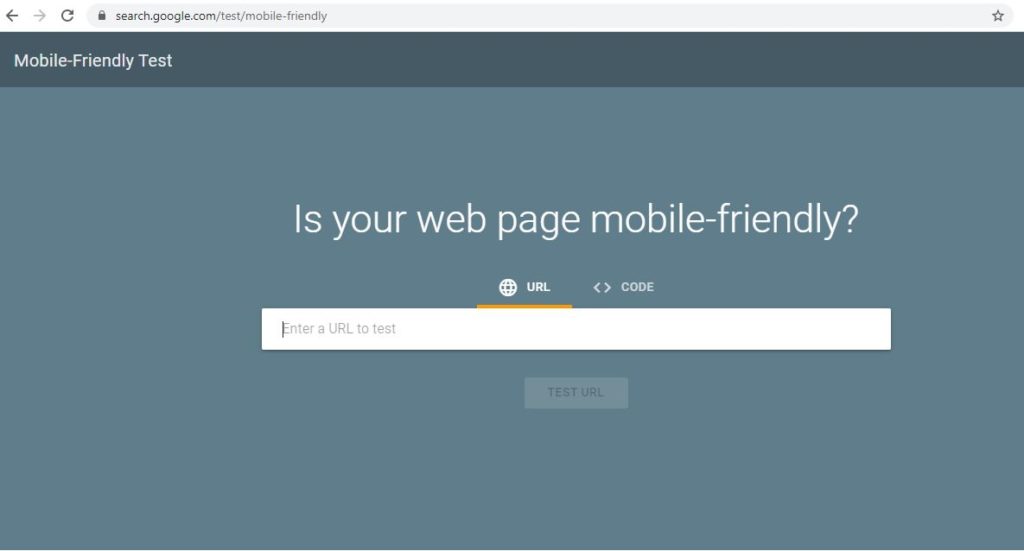
And Just insert your site URL in the given text input field like below:

And then click on the TEST URL button and the result by google after analysis.
In My case result was:
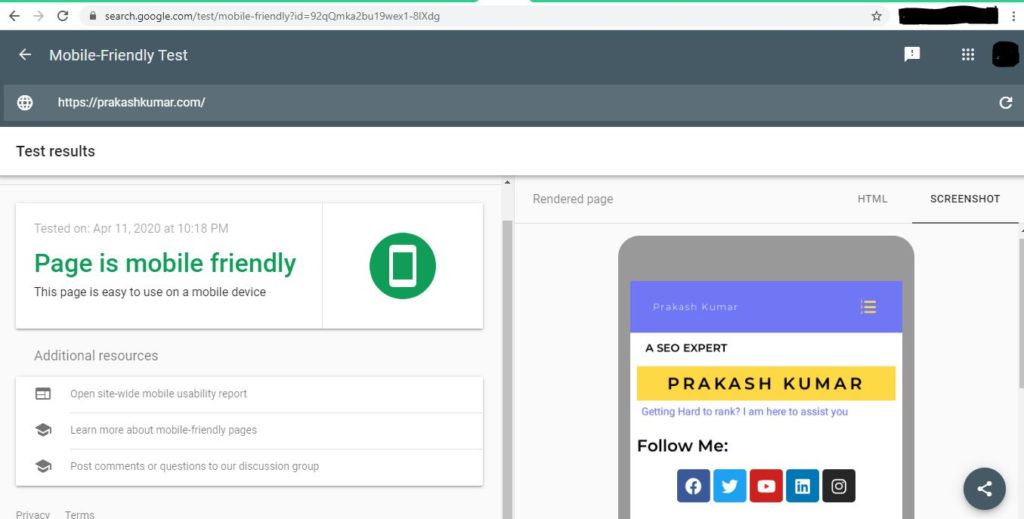
It means that my page is fully responsive and mobile-friendly 🙂
And After seeing this result I was very happy and feel like dancing.
Points to check
- Is the website mobile-friendly, with a responsive design?
- Is it adjusting the different screen sizes like mobile, tab, laptop and desktop?
- Does the website loading quickly on mobile?
- Is the font size, and other components are visible correctly and easily readable? on small screens?
- Are all buttons, menu bar and links are clickable and showing correctly?
3. Find the “zombie pages” of your website and delete it
The zombie page of a website means a page or post which does not contain any useful information that helps users to understand what they are looking for.
For example, A post which has thin content like only 50 words contains which will never get rank on search engine moreover it will kill the rest of the website’s page authority and also it will increase site bounce rate.
Suppose in a site there is a page that contains only URLs that can consider as Zombie page.
Some zombie pages are:
- Category Page of WordPress website
- Tags Page of WordPress website
- Archive Pages
- Thin content pages
4. Optimize Page Speed of your website
Google has officially confirmed that your website’s page speed would be the ranking factor of your website.
A slow speed website may harm your ranking factor.
Also, a slow speed website increases the bounce rate of your website.
It is true. Suppose you are visiting some site and that site is taking too much time to load a page then you surely close that page and move to another website.
For Example, Below I am showing my present page speed without any optimization on both mobile and desktop.
Mobile page speed
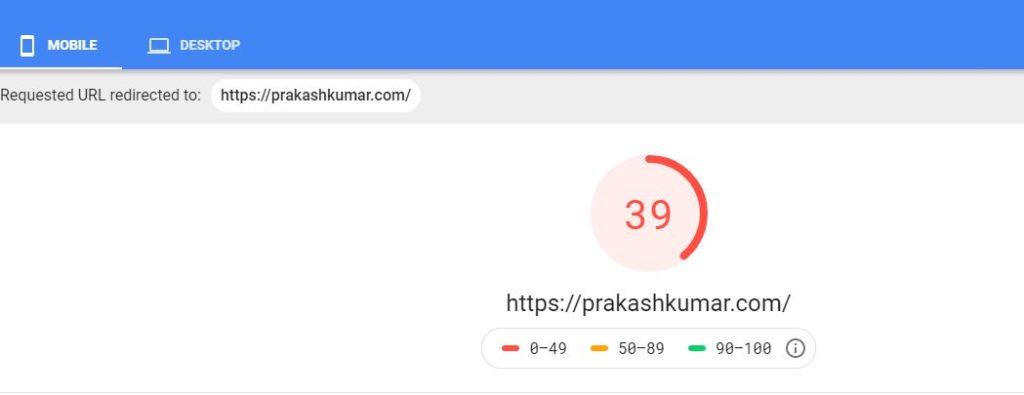
Desktop Page Speed
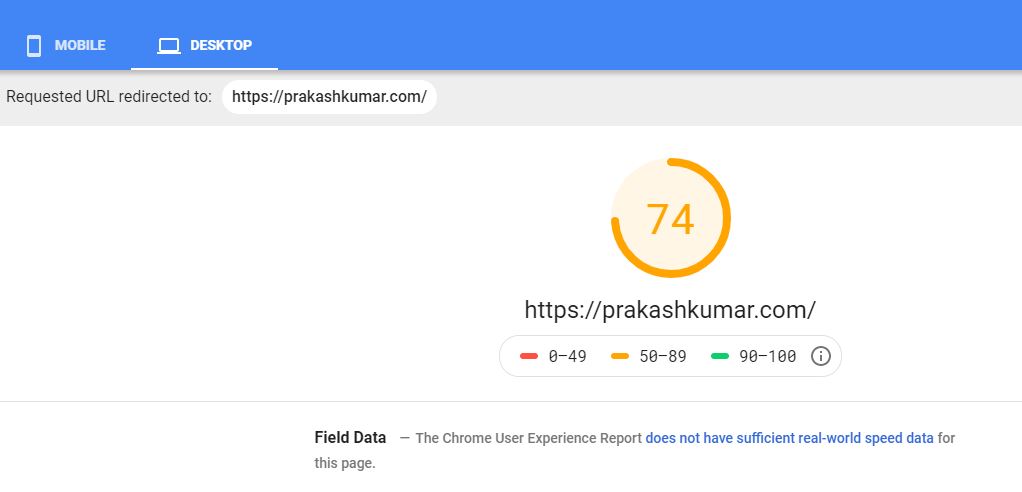
Points to check
- Does website is loading within 1-2 seconds? This should be check for all pages.
- If web page is loading slowing, is it be fixed by removing components or replacing with alternatives? (e.g. of components that cause slow load are plugins, uncompressed images, render blocking, poor server response, disabled caching etc.)
- Are there any opportunities to improve page speed even further?
5. Crawl Errors
Use Google Search Console or crawling tools to identify and fix crawl errors, broken links, and missing pages, Redirect Errors, Blocked by Robots.txt etc. Mostly you have to check the robots.txt file.
Points to check
- Has Google Search Console showing any crawl errors for the website?
- If there are some crawl error, identify the fixes for it?
6. XML Sitemap and Robots.txt
Ensure your XML sitemap is updated and your robots.txt file is properly configured to guide search engines. Also make sure that your sitemap.xml is accessible by google search console and link of post and pages are able to discover.
Points to check
- Does the website have an XML sitemap?
- Does the website have linked XML in the footer or navigation menu?
- What method has used to create sitemap? Like manual created or created by any plugin?
- Check, Is the sitemap is updating when you are uploading next post?
- Have any errors or issues with the sitemap that is showing on Google search console? That should be fixed.
- Is robots.txt file configured well and not blocking any page or post from crawl?
- Is important admin page and other private is blocked in robots.txt or not? That should be blocked from indexing.
- Is the sitemap location listed in the robots.txt file using the correct rule? (Sitemap: https://domain.com/sitemap.xml)
7. Duplicate Content and Canonicalization
Use tools to identify and address duplicate content issues. Duplicate Content is basically a similar type of content posted two times.
Points to check
- Identify duplicate content on the website.
- If there is duplicate content, proper canonical tags setup is done or not?
- Is there any technical issues causing unintentional duplicate content? ( Some are printer-friendly versions of pages or having both HTTP and HTTPS versions of pages or url is with www version of non-www version).
8. HTTPS/SSL
Confirm that your site has a valid SSL certificate for secure connections.
Points to check
- Is domain showing https correctly on every browser?
- Is domain properly redirecting to https when http is given?
9. Broken Links and 404 Errors
All page and post of the website should open properly. They should not redirect to other unwanted resources or return 404 Errors.
Points to check
- Is there any page or post returning 404 errors on the site?
- Is pagination link is returning 404 page not found error?
- Have proper steps been taken to fix these errors? (e.g., setting up correct redirects if page/post deleted, replacing broken links, etc.)
10. Schema Markup
Website should have added correct schema markup code to provide additional information about your content. It involves adding specific code to your website’s HTML to provide additional information about your content. This information is then used by search engines to create rich snippets in search results, which can enhance your site’s visibility and click-through rates.
Points to check
- Check if Schema Markup is added on the website?
- If added then check it has been done correctly with right information for each web page that needs it?
- Are there any chances to add fresh Schema Markup on the website to provide more details about website to search engines?
- Examples of schema markup include Organization Schema, Local Business Schema, Product Schema, How To Schema, FAQ Schema, Review Schema, etc.
11. Manual Actions
Check If website have got any manual actions, if yes then that needs to be fix. You can check this in google search console. Manual action basically a penalty or action taken by a human reviewer at a search engine.
Points to check
- Has the website got any manual action penalty? Check it in in Google Search Console.
- If any manual action exists, identify the cause and start fixes for it?
- If website have not got any manual actions, check if website is following google guidelines or not for the future safety.
Step 4: On-Page Content Analysis
On-Page optimization is also a very important factor in site ranking. And Also it is a truth that it is not possible to optimize each page/post of your website.
Why I am saying it?
A site may contain 300-500 pages/posts where 50-60 is most important and the rest of the posts/pages are working as engaging the user and supporting the main content page. So only optimize your important or say that pillar post.
On Page SEO Involves
1. Title Tags
Ensure your title tags is optimized well with proper length, catchy, unique and keyword placement.
Points to check
- Is there any pages without the title tags?
- Does two page has same title tags? It will cause duplicated title issue.
- Are all title tags is displaying properly in search results without being truncated?
- Do all title tags has proper uses of primary keyword?
- Has a secondary keyword been included in the title tag naturally to provide more context to users?
- Is there title using all caps or special character? That should be avoided.
2. Keyword Analysis, Usage and Density
Check if keywords are strategically placed in titles, headers, and in content. And Make sure it should not be over optimized and done keyword stuffing.
Points to check
- Are the seed keyword or focus keyword used in the introduction?
- Is the keyword density on each page is between 1-2% as per guidelines?
- Have keyword variations, synonyms, and semantically-related words are used to enhance topical relevance?
3. Meta Tags and Descriptions
Review and optimize meta titles and descriptions for each page and posts. There should be proper placement of keywords in the meta tag naturally. And also confirm that tags should not look like over optimized and unnatural.
Points to check
- Is there any post has missing meta descriptions?
- Are any of the duplicate meta descriptions existed on the website?
- Does added meta description accurately explain about the pages? Check meta descriptions relevancy here.
- Have the primary and secondary keywords for each web page been included naturally in the meta descriptions?
- Does length of meta description is in defined length which is 150-160 characters?
4. URL Structure
URLs should be human-readable and provide a clear indication of the page and post content. Check the use of descriptive words that reflect the topic or purpose of the page.
Good Example:
SEO Site Audit Checklists by an Expert – Prakash Kumar
Bad Example:
https://www.prakashkumar.com/blog/page123
Points to check
- Is the length of URLs short and easy to read?
- Does primary keyword is used in urls to make it SEO-friendly?
- Is there any unnecessary dates or numbers or special character added in URLs, that need to be fixed?
- If there are any changes in URLs, there should be a proper 301 redirect.
5. H Header Tags
Check H tags has a proper hierarchy, structure, and readability in webpages. It is an important aspect of an SEO site audit. H Tags should have proper consistency in each webpages.
Points to check
- Is every webpage contains H1 tag?
- Confirm each page have only one H1 tag?
6. Image Optimization
Images also holds good weight on the SEO Auditing. Check image is properly optimized and not taking much time to load on the page. Also check for user experience as it should not break site structure and layout. Image file, image format, size, alt text all this things need to check and fix if there is any issue.
Points to check
- All images are compressed and appropriately resized for fast loading?
- Does image have proper file format? (e.g., pictures are JPEGs and graphics are PNGs)
- Does all image has proper ALT text that is similar to keywords? If missing, add it on priority.
- Do the image filenames is similar to target keyword?
7. Content Quality
Ensure your content is informative, engaging, and relevant to your target audience. Also check that your content is not over optimized with keywords by keyword stuffing.
Points to check
- Does every page and post have unique and original content?
- Does content is originally written or rewritten from other websites?
- Is the content following user search and keyword intent?
- Check content are up to dated with correct information and worthy to share by others?
8. Internal Linking Structure
Check if site has proper internal linking or not. Proper interlinking means easy website navigation, good user experience, and helps search engines understand the hierarchy and relationships between different pages and posts.
Points to check
- Is there any page that is not linked with other page? It is treated as orphan page/post.
- Is there proper internal links to other relevant content? (One page should send link to 2-5 other page of the website).
- Does important pages are accessible from the homepage?
- Do the most important web pages have at least 5-10 incoming internal links?
- Are the most important web pages linked internally from other high authority pages to capture the most link equity for SEO?
- Whether anchor text is keyword reach while creating internal link or not? Interlink should have proper keyword that is linking the targeted page/post.
Step 5: Backlink Analysis
Analyze your website’s backlink profile:
1. Backlink Quality
Evaluate the quality and relevance of your backlinks. Disavow toxic or irrelevant links by using google search console. Audit backlinks to check website’s link profile, its authority, and potential areas for improvements. Some steps includes are backlink data collections and analysis, Checking domain quality, Link Diversity, No Follow and Do Follow Ratio.
Points to check
- Does website main domain have similar or better referring domains in compare to the top-ranking competitors on search engine?
- Does the pillar page/post have good quality backlinks as the top-ranking competitors?
- Is there any post or page have low quality incoming link?
- If the website or web pages has low-quality backlinks, remove them by contacting the website owners or remove it using Google’s Disavow Tool?
- Does the website has mix backlink footprint or its same type of link? A good mix of dofollow and nofollow links that indicate a natural backlink profile?
2. Anchor Text
Check for unnatural or over-optimized anchor text. Diversify anchor text distribution by using the similar type of keywords. In anchor text auditing collect the anchor text data check its diversification to look like natural.
Points to check
- Is there any web pages or post on which high percentage of backlinks is coming from exact match anchor text? It will be like over optimizations and treated as link scheme is being used?
- Is there any low-quality or spammy sites that are linking to the website with exact match anchor text?
- Is there a good mix of branded, partial match, phrase match, and natural anchor text for the backlinks to each web page?
Step 6: User Experience (UX) Evaluation
Assess the user experience and site design:
1. Navigation and Site Architecture
Ensure intuitive navigation and organized site structure for better User Experience. Here you have to ensure that website has user-friendly and search engine friendly architecture.
Points to check
- Does website has clear and intutive menus? Ensure that it is clear, consise so that user can easily find information that they need.
- Is website breadcrumb is working fine or have any navigation error?
2. Mobile Usability and Page Layout
Confirm seamless user experience on mobile devices. Check all website component is working fine or not on mobile device. Also checks any layout break issues if there are.
Points to check
- Does website is mobile responsive and loading correclty on mobile device?
- Is all components are working fine on mobile deivce?
- Is font is visible correctly and able to read by end users?
- Does website is loading fast on mobile device? Check with mobile network as well as with wifi network.
- Does AMP (Accelerated Mobile Pages) is setup? If yes check it is done correctly or not? And if not then check if you can apply it or not?
Step 8: Local SEO (if applicable)
For local businesses, consider it:
1. Google My Business
Optimize your GMB listing for accurate information. Ensure accurate and up-to-dated information is available to potential customers or not.
Points to check
- Does the business have verified Google Business Profile?
- Check if profiles are fully optimized with correct information or any important information are missing? (check product description, service descriptions, contact details, Opening hours and the website address)
- Does business is sharing relevant and high-quality images or not?
- Are profile is updated by business owner on regular basis or not?
- Is business is answering on customer questions on a timely basis?
2. Local Citations or Business Listing
Ensure consistent NAP (Name, Address, Phone) information across directories.
Points to check
- Does all the top business directory website has business information or any left to consider?
- Is the business details are same and consistent across all online platforms and directories?
- Is there any typos or errors in the NAP(Name, Address, Phone Number) information that need to be fixed?
- Has a listing been claimed on each of those business directories?
- Are the business listings optimized with relevant keywords, categories, and tags to help potential customers find the company online?
Step 9: Analytics and Performance
Review your website’s analytics:
1. Traffic Analysis
Analyze organic search traffic, user behavior, and conversion rates on the various google tools like google analytics, search consoles etc.
2. Goal Tracking
Set up and track relevant goals in Google Analytics. And check if business are able to achieve those goal or not?
Step 10: Create an Action Plan
Compile your audit findings into a comprehensive report. Prioritize issues and create a detailed action plan with steps to address each problem.
Step 11: Implement and Monitor
Start implementing the changes according to your action plan. Regularly monitor progress using tools, analytics, and search console data.
Step 12: Continuous Improvement
SEO is an ongoing process. Regularly review and update your SEO strategies to adapt to algorithm changes and evolving best practices.
Remember, each website is unique, so tailor your audit to your specific goals and target audience. An SEO audit is a powerful tool for optimizing your website’s performance and enhancing its visibility in search engines.
